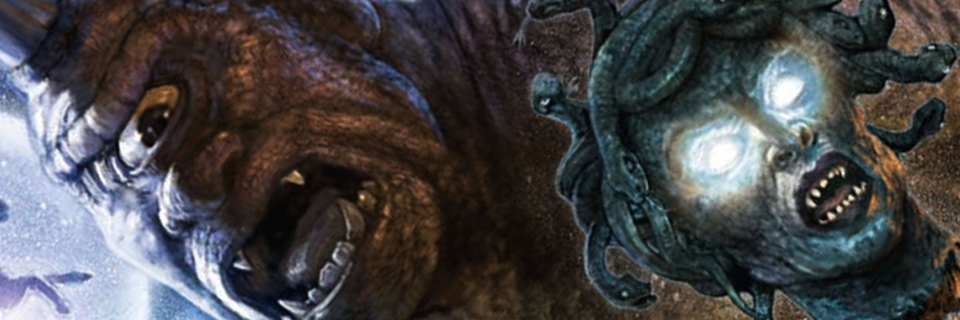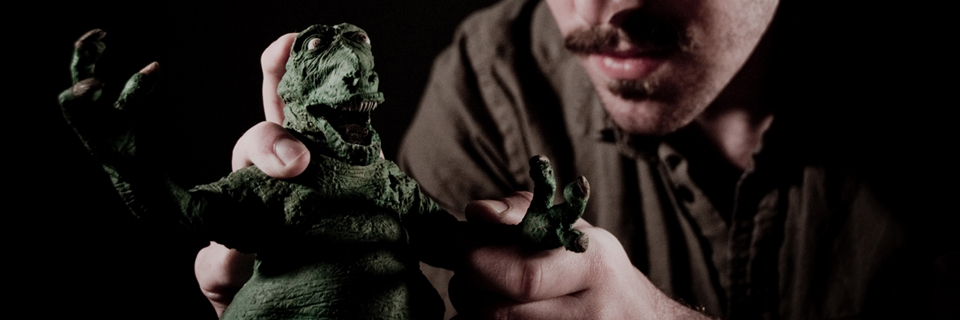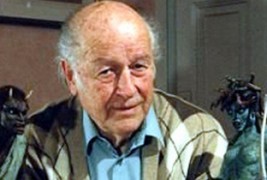
“I had to do everything because I couldn’t find another kindred soul. Now you see eighty people listed doing the same things I was doing by myself.”
Sometimes people ask me why I’m so crazy for monsters and so interested in the weird. I have no trouble tracing my inspiration all the way back to the age of four. How much can you remember from that age, when you were still mastering how to walk and figuring out how to put sentences together? For most of us, not much, but I remember one thing that changed my whole life. I saw Jason and the Argonauts.
My Mom and Dad didn’t know anything about it. Back in those days, I was supposed to be in bed by 8:00 if not before. Also, although it seems hard to believe it in these days when zombies are disemboweled on prime time TV, many parents wanted to protect their kids from stuff that was “scary”. Well, I couldn’t sleep for one reason or another, so I snuck out of my bedroom and hid behind a living room couch while my Dad watched TV.
Now my Dad was no fan of sci-fi or horror for the most part, but on this particular night, he was caught up in the network TV broadcast of a movie that I didn’t know the name of then but one that years later I would recognize as Jason and The Argonauts. I remembered two funnily dressed guys standing in a valley in front of a building with an enormous giant statue on top of it. And then, while I watched with four year old eyes, that…statue…MOVED. With an ungodly creak, it turned its giant head and looked down at the puny humans below….
I can’t describe what I must have felt then, but I was rooted to the spot and kept watching the show with the big metal giant. More amazement was to come. I was scared stiff as a helpless old man was tormented by winged demon creatures. I saw a giant half-man/half-fish hold back crumbling cliffs while a ship sailed beneath him. I saw a monstrous giant snake with seven heads battle a hero with a sword. And then, to top it all off, SKELETONS rose from the ground to attack and kill the heroes!
It was too much and I’m sure I must have had nightmares that night. But the fascination of the monstrous and the bizarre was planted in me and to this day, that fascination remains and has grown. If I can share some of my enjoyment of weird creatures with you humanoids, then I’m a pretty happy camper.
And one man was responsible for the wonderment of Jason and the Argonauts. That man was Raymond Frederick Harryhausen and he has been a hero to me for many years. No greater special effects man has ever graced the world or ever will. It’s one thing to create monsters and odd beings that look like they are alive. It’s another thing entirely to give them a soul. And Ray Harryhausen was surely able to do that, much the same way that the sculptor Pygmalion brought the beautiful statue Galatea to life.

Ray died this year at the ripe old age of 92. Nobody can say he got cheated out of life. Many celebrity deaths pass through my mind with barely a ripple, but I felt great sadness when Ray passed. He was a true mentor and inspiration to me even though we never met. Nowadays, a team of 80 computer geeks try to dwarf his achievements…and fail. Because no CGI will ever have the heart that Ray Harryhausen put into his monsters.
He was born in 1920 in Los Angeles, California, son of Frederick and Martha Herrenhausen. He was 13 years old when he had the epiphany that changed his life forever—seeing the original King Kong in the theater. That masterwork of the imagination ignited a fire in the mind of inventive young Ray and he feverishly set to work in his Dad’s garage trying to recreate the ground-breaking special effects of Kong’s FX mastermind, Willis O’Brien. It was O’Brien who pioneered the technique of stop-motion animation, creating movable figures filmed one tiny movement at a time to create a semblance of life. O’Brien had stunned the world with The Lost World and then again with King Kong.
Harryhausen had a chance few others ever had: he got to meet his hero and inspiration. He met O’Brien while still a teenager and the two established a relationship of master and apprentice. At the same time, Ray also became a member of a club of gifted creators who would chart the future of fantasy and science fiction. Most notable among these lifelong friends would be writer Ray Bradbury and entrepreneur Forrest J. Ackerman, who later created the Famous Monsters of Filmland magazine.
Ray slowly started to put together a film career. His first real job was doing “Puppetoon” animated cartoons for George Pal, himself a fantasy creator of no small fame. During World War 2, he also worked with one Frank Capra as a jack-of-all-trades, learning the entire business of making movies, not just special effects.
Harryhausen’s first huge break came when he worked with O’Brien on 1949’s Mighty Joe Young, the story of a giant gorilla brought over from Africa to become part of a Broadway show. It’s still not known just how much of the movie’s actual effects were done by Harryhausen, but O’Brien was slipping physically and mentally at the time, so it’s fair to say Mighty Joe Young was his trial by fire. To this day, the film is a beloved favorite of many classic monster movie buffs.
It was then time for Ray to step out on his own and his first solo foray into the movies was a monstrous one. He created and brought to life the title character of 1953’s The Beast from 20,000 Fathoms, which was adapted from a story by his friend Ray Bradbury. This was the first of the ‘50s many “giant monster on the loose” films and probably the best. The movie was a certain inspiration to Japan’s Inoshiro Honda, who used it as a template for his own Gojira, better known to the West as Godzilla.
For Beast… Ray brought to life a vicious dinosaur called the Rhedosaurus, which atomic testing freed from an icy slumber in the arctic. The ravenous beast then returns to its original breeding grounds…now New York City. Audiences of the time were stunned by the realism Ray brought to the Rhedosaurus, who was truly a bloodthirsty brute. The scene where the monster devours a cop in one gulp is a classic in horror film history.
Beast… was a hit and got Ray’s name noticed. He made the acquaintance of producer Charles Schneer and the two collaborated together for many years, creating some of the most famous monster and fantasy films ever. 1955 brought It Came From Beneath the Sea, the story of a giant radioactive octopus that attacks San Francisco. The production was so low budget that Harryhausen could only give “It” five arms instead of eight. Despite this, the effects were again outstanding and the film was a modest success.
The next year saw Ray dabble with a different kind of science fiction. For Earth vs. The Flying Saucers, he created no prehistoric monsters or gigantic beasts, but instead devised a fleet of spinning flying saucers hell bent on destroying the world. More than any other picture he worked on, this one allowed Harryhausen to cut loose with scenes of destruction, including the Washington Monument and the Capital Dome itself being totally wiped out by the invaders.
Ray was now on a roll and the classics came thick and fast. 20 Million Miles to Earth brought perhaps his greatest monster, the Ymir. Originally a tiny being brought from Venus, this half-reptile/half-ape creature grew into a towering monster in Earth’s atmosphere. The personality that Harryhausen imbued the Ymir with was amazing. It seemed a better actor than the stiff humans who were co-acting with it. For the entire picture, your sympathy is with this poor monster, even when it’s on the rampage. It didn’t ask to be brought to Earth. And once it’s here, it gets chased, stabbed with a pitchfork, attacked by dogs and shot by the Army. No wonder it has such a bad temper. The Good Doctor considers the Ymir the greatest of all stop-motion monsters…yes, even greater than mighty Kong himself.
Following 20 Million Miles…, Ray and co-conspirator Charles Schneer embarked on the most ambitious phase of their careers. Leaving behind the typical sci-fi concepts he’d been dabbling with before, Ray dived headlong into the world of pure fantasy with The Seventh Voyage of Sinbad. For once, he had a good budget to work with and a movie in color. The result was an all-time classic, full of great Harryhausen creations like the horned giant cyclops, the huge two-headed roc bird, a fire-breathing dragon and a living skeleton warrior. Accompanied by the thunderous music of Bernard Herrman, the movie was a huge success.
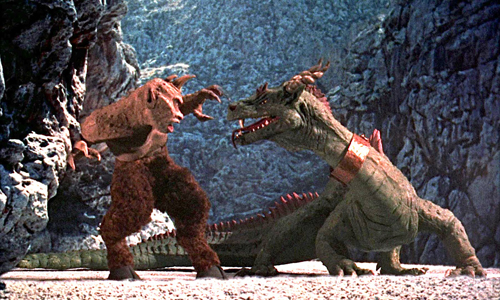
The 1960s were Ray’s glory years. He did The Three Worlds of Gulliver in 1960 and then the rollicking Jules Verne adaptation Mysterious Island the same year. This last movie is a special favorite of mine, with an exciting story full of giant monsters and more great music from Bernard Hermann. The sequence where giant bees trap two castaways in a monstrous honeycomb is amazing to watch and the film is also notable for the performance of Herbert Lom as Captain Nemo.
In 1963, Harryhausen, Schneer and Hermann released what many consider their masterwork, Jason and the Argonauts. I described the many stop-motion wonders of this movie earlier, so no need to rehash them here. I’m guessing you’ve probably seen the movie at least once yourself. If not, then what are you waiting for? It’s easy to find. Those who “ooh”-ed and “ah”-ed over the single skeleton warrior in The Seventh Voyage of Sinbad must have been ready for the bughouse when they saw a literal army of skeletons on the warpath here.
Without a doubt, Harryhausen’s special effects, along with Herrmann’s huge musical score, make the picture memorable, but I’ve always thought the clever script and good performances have been underrated, especially Todd Armstrong’s “everyman” version of Jason and Niall McGinnis’s superb portrayal of Zeus. Add the lovely Nancy Kovack as Medea and the authentically beautiful Mediterranean scenery and you have a genuinely classic picture. Yet Jason and the Argonauts was not a success at the time it was released. Perhaps too many people lumped it in with the boatload of cheesy muscleman flicks coming from Italy at the time. It’s fair to say, though, that any young kid of a certain age who saw this movie had their life changed by it. You’re reading the words of one right here.
After Jason, Harryhausen turned towards science fiction again, helping to bring H.G. Wells’ First Men in the Moon to life. This peculiar film told the story of Victorian explorers who landed on a moon inhabited by strange insect-like aliens called the Selenites. This movie is rarely spoken of as one of Ray’s best, but I feel his stop-motion work is excellent, particularly his “Grand Lunar”, the leader of the Selenites, as well as a giant caterpillar-like creature.
First Men in the Moon was another box office disappointment and Ray’s long contract with Columbia Pictures came to an end. A wave of rebellion and change was sweeping across the movie world and no doubt some of the new wave of filmmakers considered Harryhausen’s work old-fashioned. As time has moved on, that work now looks timeless while the rebellion pictures of the ‘60s are the ones that seem horribly dated.
Harryhausen’s next project was working for England’s Hammer Studios, known for their Gothic horror films. Now, though, they needed Ray’s work for their ambitious update of One Million B.C., the story of cavemen struggling to live in a savage prehistoric world. The movie was exciting entertainment, featuring Ray’s great dinosaur creations. For the first time in his career, though, his special effects had to take a back seat to something even more spectacular: young Racquel Welch in a fur bikini. Even the monsters swooned when they saw her.
One Million B.C. was a success and it gave Harryhausen the space he needed to attempt a personal project he had wanted to do for decades, a tale called The Valley of Gwangi. This was a story conceived of by his mentor Willis O’Brien back in the ‘30s which told of cowboys capturing a living tyrannosaurus in a Mexican “lost world” and bringing it to civilization. The scene in 1949’s Mighty Joe Young where cowboys roped the giant ape was originally meant for Gwangi and it appeared as intended in the 1969 movie. Harryhausen considered Gwangi the T-Rex one of his greatest creations so he was crestfallen when the movie was a huge flop financially. Both Westerns and monster movies were out of fashion at the time and Valley of Gwangi suffered because of this.
The reception to Gwangi caused Ray to lose heart and the next few years saw him contemplating retirement. His old friend Charles Schneer came to the rescue and managed to work out a new deal with Columbia Pictures. The result was 1974’s Golden Voyage of Sinbad, which saw Harryhausen return to the Arabian fantasy world he had pioneered 16 years before. Although many would disagree, I actually find Golden Voyage to be a better movie. Bearded and athletic John Philip Law made for a much better Sinbad than Kerwin Matthews in did Seventh Voyage and the movie had a spectacular villain in the form of Tom Baker as the evil magician Prince Koura. This was Baker’s last role before becoming the most beloved version of Dr. Who. Also worthy of a mention is gorgeous, curvaceous Caroline Munro as a beautiful slave girl. She gave even Racquel Welch a run for her money in the feminine pulchritude department! As for Ray’s effects, they were top notch once again, with the most impressive sequence being the battle between Sinbad and the living six-armed statue of the goddess Kali.
Golden Voyage of Sinbad was such a big hit that Seventh Voyage was re-released to theaters and immediate plans were made for a sequel, Sinbad and the Eye of the Tiger. That follow up was released in 1977 but few felt the movie equaled the thrills of Harryhausen’s earlier Sinbad movies. For this one, Patrick Wayne, son of “The Duke” himself, played Sinbad and the movie boasted performances from lovely Jane Seymour and another Dr. Who actor, Patrick Troughton. Although the effects sequences were impressive, the movie seemed to lack a spark and failed to duplicate the success of its predecessors.
Ray’s career was winding down, but the 1980s brought him one last great hurrah, 1981’s Clash of the Titans, another epic of Greek mythology much in the mode of Jason and the Argonauts. Now released by MGM, Clash had a truly big budget and featured an assembly of top-rank actors like Laurence Olivier and Burgess Meredith. It told the story of noble Perseus, who killed the hideous Medusa and used her decapitated head to defeat the monstrous Kraken. The Kraken (named somewhat strangely after a Norse sea monster) bore more than a passing resemblance to Ray’s great creation, the Ymir, of many years before. But the highlight of the movie is the incredible scene featuring Perseus’ confrontation with Medusa in a dimly lit temple. Ray’s reptilian version of Medusa is a masterpiece and the scene is a triumph of lighting and suspense.
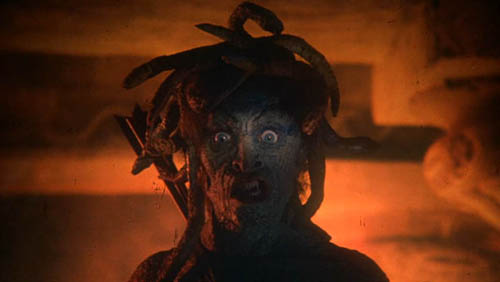
Clash of the Titans was a box office hit, yet the Hollywood scene had changed and become more corporate. Bean counters had disdain for Ray’s painstaking effects compared to those used in the wildly popular Star Wars movies. Schneer and Harryhausen had plans for a sequel to Clash called Force of the Trojans but were frustrated by studio politics and gave up on it. That marked the end of Ray Harryhausen’s brilliant career as the master of movie special effects.
As the years rolled on, more and more of the new breed of fantasy and science fiction creators paid tribute to the man who inspired them. Filmmakers like Peter Jackson, Sam Raimi and George Lucas, along with many others, made no secret that they were huge fans of Ray’s work. Once-ignored films like Jason and the Argonauts and Mysterious Island became widely worshipped cult classics. No less a mainstream superstar than Tom Hanks paid tribute to Ray when he told an Academy Awards crowd in 1992 this: “Some people say Casablanca or Citizen Kane. I say Jason and the Argonauts was the greatest movie ever made.”
Ray aged gracefully in the ‘90s and into the 21st century as the elder statesman of special effects. He was a frequent guest at many conventions and was very gracious in praising the new computer-based effects of modern times. For once, I had to disagree with him. No CGI has ever equaled the warmth and character that Harryhausen infused his creations with.
When I heard the news that Ray passed away on May 7, 2013, I knew the greatest of all Hollywood FX maestros was gone. Despite that, I’m happy that Mr. Harryhausen lived long enough to enjoy the fame and adulation he certainly had earned. There will never be another like him.
“I’m very happy that so many young fans have told me that my films have changed their lives. That’s a great compliment. It means I did more than just make entertaining films. I actually touched people’s lives and, I hope, changed them for the better.”


